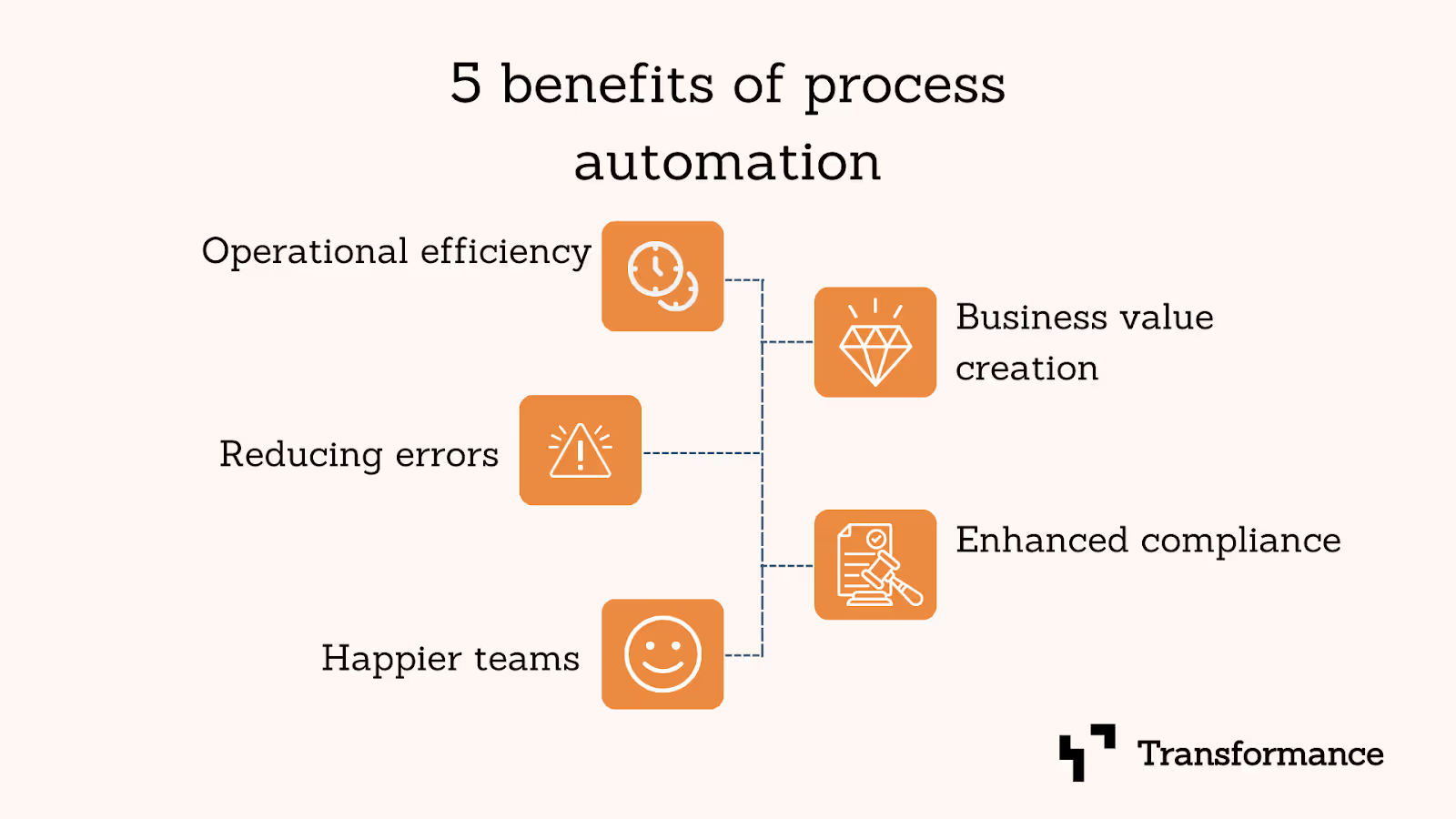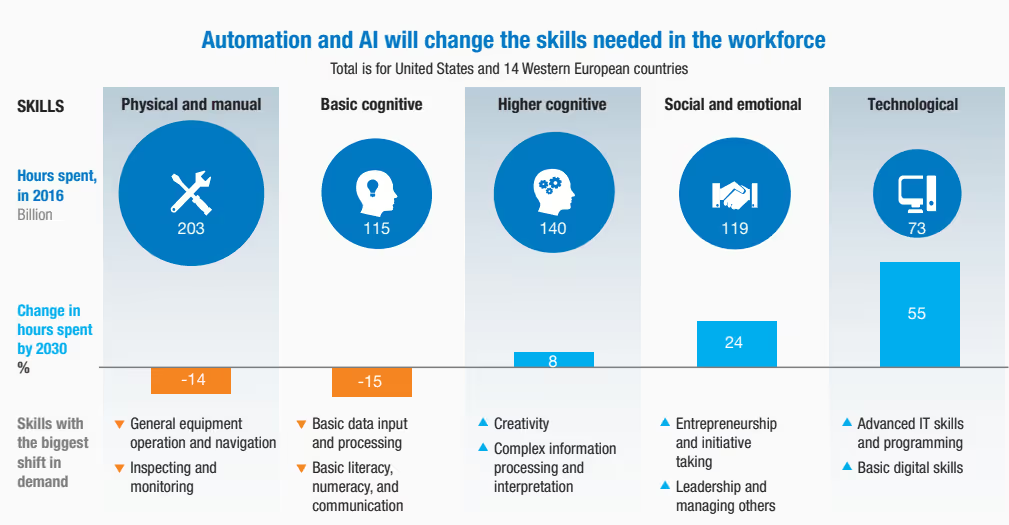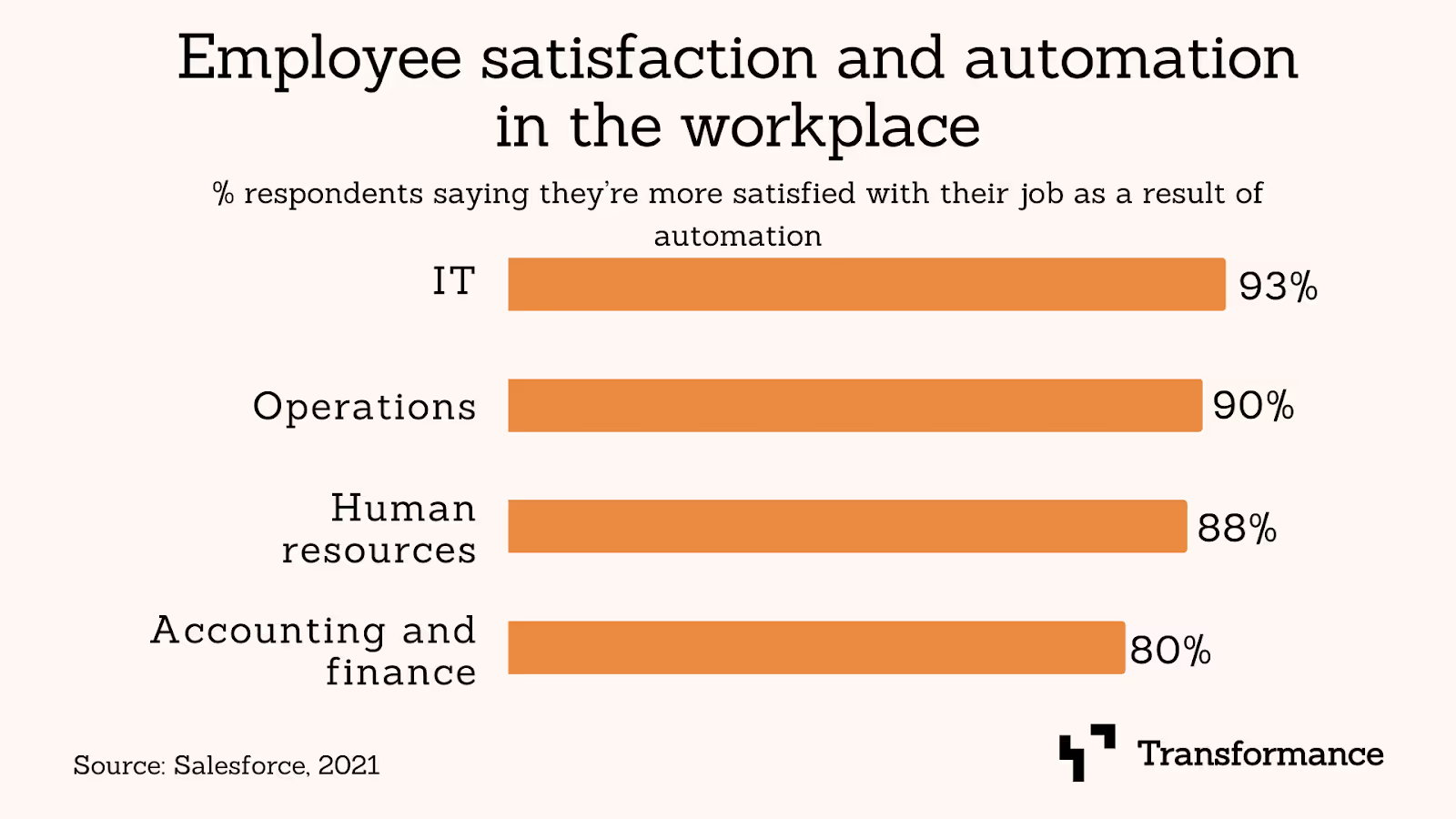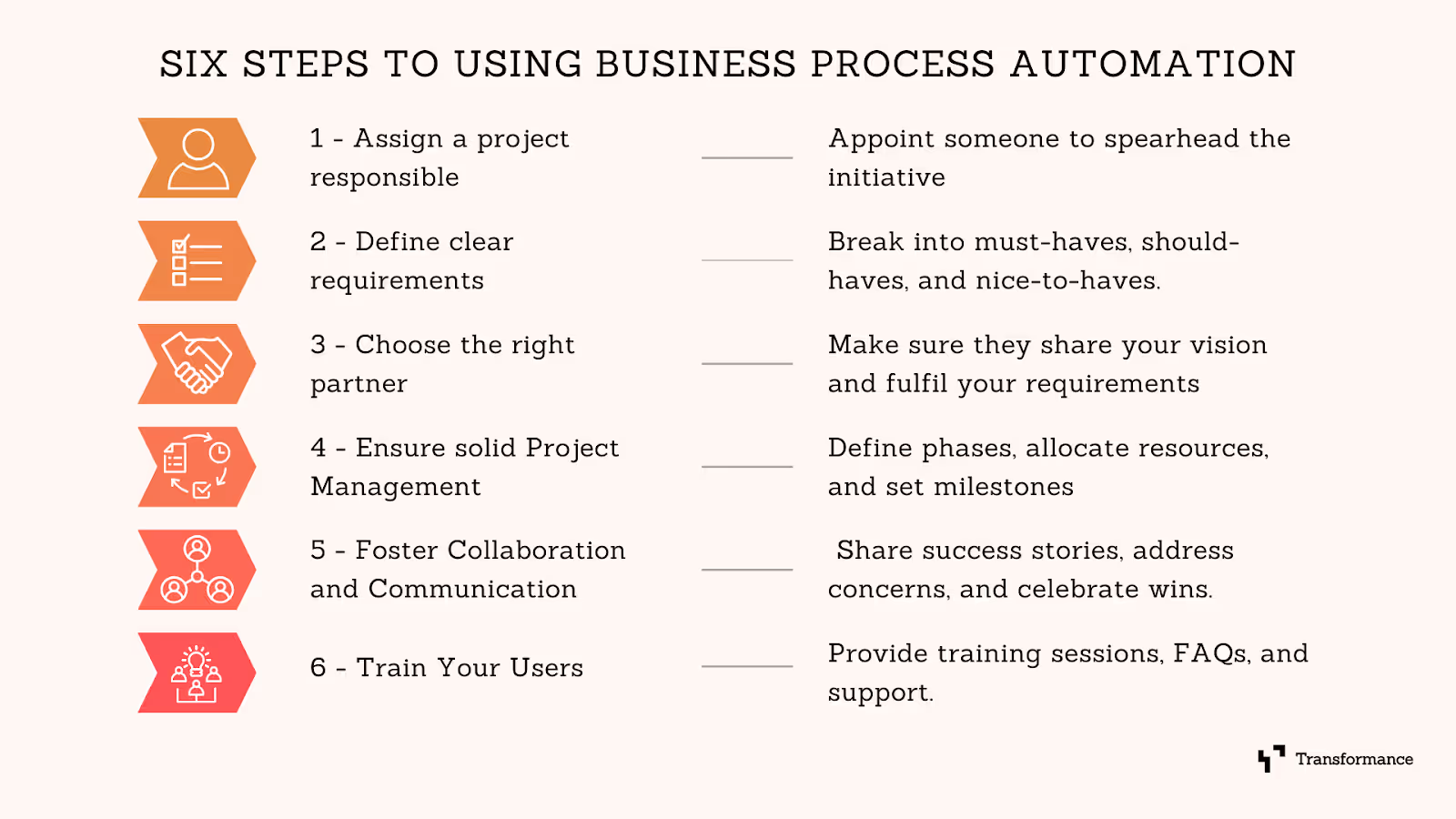BPA platforms are the most deployed form of automation, according to McKinsey, as they can be most horizontally applied.
Surveys show that prioritizing automation has become increasingly important for achieving efficiency gains.
According to research firm IDC, however, only 26% of automation projects are successful. This article aims to be your starting point for a successful automation implementation.
It explains how business process automation works, what the benefits of business process automation are, and the 6 steps to getting started with the right business process automation solution.
For a full summary of business process automation read our article “What is business process automation?”
How Does Business Process Automation Work?
Business process automation works by integrating various software applications to perform tasks that would otherwise require manual intervention. This can include anything from data entry to customer service interactions.
Most platforms have a no-code or low-code environment in which users can replicate their process workflows digitally and automate them end-to-end. Oftentimes, the digital workflow will include other automation solutions such as AI-image recognition (e.g., for reading invoice PDFs) or machine learning (e.g., for matching unstructured data).
Advanced tools like Transformance go beyond simple integration of software to syncing data fields. They have an AI-agent team of developers to bridge the gap between IT and business, ensuring more intelligent and context-aware automation. Transformance not only accelerates IT development but also enables automatic documentation for compliance and fosters seamless collaboration between stakeholders. With its AI-driven agent, users can build full-stack custom applications in minutes instead of weeks, automating complex business processes through natural language inputs. This transformative capability eliminates the need for coding expertise or deep analytics skills, making Transformance the ideal partner for forward-thinking organizations
The Benefits of Business Process Automation
As we discussed in the introduction, business process automation is an important emerging trend that more and more enterprises adopt. Here are the 5 major reasons why businesses adopt business process automation tools and why you should consider doing the same.

Increase operational efficiency
When speaking to executives about why they need more automation in their business, operational efficiency is the most quoted.
Business process automation enables teams to streamline their processes by automating repetitive tasks while reducing manual effort and errors. This results in faster turnaround times for all team projects and ongoing to-dos. The more a process is automated and standardized, the faster high quality information and data can flow through the enterprise. A study by Gartner reports that automation could save up to 30% of a full-time employee’s time in the finance department. This equates to 25,000 hours annually, potentially saving $878,000 for an organization with 40 full-time accounting staff.
Create business value
One of the most significant benefits of business process automation is its ability to free up valuable human resources. By automating routine tasks, teams can not only reduce the time spent on repetitive tasks but also redirect their efforts towards more strategic initiatives, fostering innovation and driving growth.
Mckinsey’s research found that automation and AI will change the amount of time spent on various activities. For example, the amount spent on basic cognitive skills, such as data input and processing, will decrease by 15%. Similarly, hours spent for physical and manual skills are expected to decline by 14%.
Such studies indicate that automation can enhance productivity by saving time from manual tasks, allowing employees to focus more on complex, creative, and critical decision-making activities making your enterprise more agile and innovative as a result.

Reduce errors and improve data consistency
Be it in posting your SAP CATS timesheets or finance journal entries, business process automation can help you maintain better data quality throughout your ERP and in all the adjacent systems in your enterprise. Because machines and code do not fall victim to many weaknesses of us humans, business process automation tools can help your teams reduce errors and thus enhance data quality throughout your organization.
In addition, the increased efficiency of processes explained above, ensures that this accurate and consistent data is available faster and can thus have more real-time impact.
Enhance compliance and risk management
Compliance and risk management are important for all enterprises and by extensions for their automation processes. Especially the Finance, Accounting, and Controlling but also HR and procurement data is crucial to enable comprehensive audit-trails and guarantee, e.g., tax compliance. Processes which are too manual can increase compliance risks where data trails become inconsistent and human error leads to data breaches.
By automating repetitive tasks and assuring fast and consistent data flows, business process automation enhances compliance and risk management for all enterprises regardless of their IT landscape.
Create happier teams
Last but certainly not least, smoother processes and reduced dependency on complicated VBA or Excel models lead to happier teams. In a 2021 survey, Salesforce found that “89% [of employees] are more satisfied with their job and 84% are more satisfied with their company as a result of using automation in the workplace”. The following chart shows the satisfaction across teams - while teams like IT lead the pack in terms of satisfaction, even the lowest ranking team - accounting and finance - counts 4 in 5 of its members more satisfied than without automation.

Six steps to using business process automation
Getting started with business process automation should not be seen as the mere introduction of a tool but the transformation of your processes and thus your business.
It is important that your company and teams follow a structured approach to introducing process automation to ensure that your team believes in the value it brings, to focus on solving the right problems with the right partner, make the implementation efficient, and lastly succeed in transforming your enterprise into a more automated, future ready one.

Step 1: Assign a Project Responsible
First things first—appoint someone to spearhead the BPA initiative. This person will rally the troops, set expectations, and keep the project on track. Think of them as the BPA champion. They should have a clear understanding of the business processes and the authority to make decisions.
Tip: Choose someone with strong communication skills and experience in managing cross-functional teams.
Step 2: Define Clear Requirements
Now, let’s get specific. What processes do you want to automate? Gather input from stakeholders, identify pain points, and create a wish list. Break it down into three categories:
- Must-Haves: These are urgent non-negotiables. The essential tasks that need automation ASAP.
- Should-Haves: Important but not urgent. Prioritize them based on impact and effort to implement.
- Nice-to-Haves: The cherry on top. If resources allow, automate these too.
Tip: Use a structured approach to define decision criteria. Your colleagues’ inclination will be to rank all their wishes as “must haves”. Limit the number of votes your team has fairly to, e.g., a maximum of 3 per person to avoid indecision. For more tips, check out this resource on defining decision criteria for more insights.
Step 3: Choose the Right Partner
Selecting the right partner to implement BPA is probably the most crucial part of your decision. We wrote “11 Tips for Choosing the Right Business Process Automation Software” Read this article to find out how Transformance stacks up against other BPA providers.
Tip: Evaluate potential partners based on their ability to integrate with your existing systems, how future-proof they are and their ability to execute successful implementations.
Step 4: Ensure solid Project Management
Implementing BPA requires a roadmap. Break it down into phases, allocate resources, and set milestones to hold yourselves accountable. Regular check-ins keep everyone aligned. For a best practice read on good project management we recommend this article.
Tip: Use an easy-to-use project management tool like Asana, Airtable, or Trello to track progress and manage tasks efficiently.
Step 5: Foster Collaboration and Communication
Introducing BPA to your team - just like any major transformation - isn’t a solo act but a conscious change management effort. Encourage cross-functional collaboration. Share success stories, address concerns, and celebrate wins together.
Tip: Schedule regular check-ins and set up a dedicated project communications channel in Teams or Slack to ensure all voices are heard and everyone stays informed. Making sure everyone can start at their own pace will make adoption much more seamless.
Step 6: Train Your Users
Finally, empower your team. Provide training sessions, FAQs, and support. The more they understand BPA, the better they’ll wield its magic. Transformance includes great support resources. Book a free consultation to learn more about our project management approach.
Tip: Create a comprehensive training program that includes hands-on sessions, documentation, and ongoing support.
Summary: 6 steps to using BPA
Implementing Business Process Automation (BPA) can transform your organization by increasing operational efficiency, increase business value, reduce errors, enhance compliance, and increase team happiness.
6 steps enable you to be among only 26% of companies where automation implementations succeed:
- Assigning a dedicated project responsible helps you push forward your initiative and align all stakeholders
- Defining clear requirements should include all relevant stakeholders and should follow fair and transparent prioritization criteria
- Choosing the right BPA partner, like Transformance, is tantamount to assuring good collaboration and support throughout your automation journey
- Using solid project management is crucial to keep your project on track
- Fostering collaboration and communication through regular check-ins and dedicated channels will assure that all stakeholders are on board with the necessary change management
- Investing in training your users is needed to maximize the benefits of your BPA transformation
Want to get your BPA journey started? Book a free 30-minute consultation to learn how Transformance will help you unleash the power of AI-driven automation.






